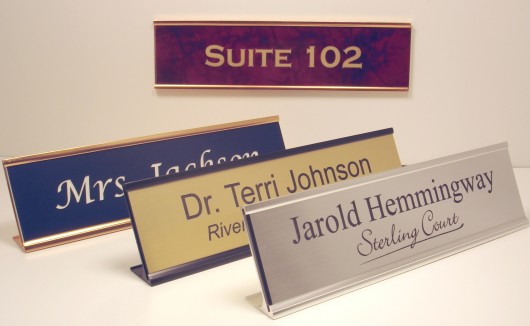 Jan
24
Jan
24
Name Plates in India
- January 24, 2018
- 0 Comment(s)
A designer nameplate identifies and displays a person or product’s name. Nameplates are usually shaped as rectangles but are also seen in other shapes, sometimes taking on the shape of someone’s name. The primary use of nameplates is for informative (as in an office environment, where nameplates are mounted on doors or walls in order to identify employees) and commercial purposes (as in a retail environment, where nameplates are mounted on products to identify the brand). Whereas name tags tend to be worn on uniforms or clothing, nameplates tend to be mounted onto an object (e.g. cars, amplification devices) or physical space (e.g. doors, walls, or desktops). Nameplates are also distinct from name plaques.

Plaques are items of larger dimensions that are designed to communicate more information than a name and title.
Nameplates are also popular for personal reasons. Parents often like to adorn the doors of their children’s rooms with nameplates. These nameplates are conventionally crafted out of wood, not plastic or metal. Because the nameplates are meant for children, these personal nameplates tend to come in fun shapes. Examples of fun shapes include teddy bears, bluebirds, dogs, and the child’s name. These nameplates also tend to be more colorful than office nameplates. Mounting options are either by a nail or by adhesive. Wooden nameplates are not normally glued onto doors, as the glue may leave a messy residue and make it harder to remove the nameplate. Larger personal nameplates also include graphics or artwork, such as a horse or a baseball bat, that match the interests of the identified person. The graphics or artwork reinforce the individuality and personalization established by the nameplate.

There is a growing trend to use nameplates for vanity purposes. In these cases, the nameplates are fashioned out of gold, silver, or other metals and worn as a form of jewelry. These nameplates are similar to vanity plates found on automobiles. They are available in a multitude of styles and colors, ranging from bronze to pink. Most commonly, these vanity nameplates are worn as necklaces or bracelets.
Office nameplates generally are made out of plastic, wood, metals (stainless steel, brass, aluminum, zinc, copper) and usually contain one or two lines of text. The standard format for an office nameplate is to display a person’s name on the first line and a person’s job title on the second line. It is common for organizations to request nameplates that exclude the job title. The primary reasons for excluding job titles are to extend the longevity of a nameplate and to promote a culture of meritocracy, where the strength of one’s thoughts are not connected to one’s job title. Nameplates without job titles have longer lives because someone can reuse the same nameplate after changing job titles. It is rare for an office nameplate to contain three or more lines of text.
Related post: HOW TO WRITE WITH A CALLIGRAPHY PEN
Graphic overlay nameplates are constructed from hard-coated polycarbonate, hard-coated polyester or UV resistant polyester. Graphic overlay nameplates differ from generic nameplates in that they feature transparent windows, selective texturing, embossing, abrasion protection and chemical resistance. A graphic overlay is usually over some sort of LEDs, windows, switch, or control panel.
Source: WIKihow
